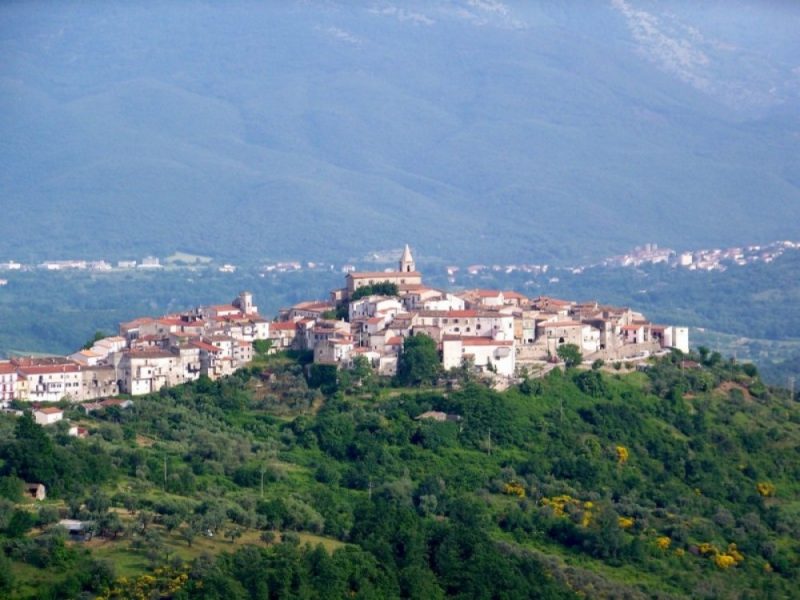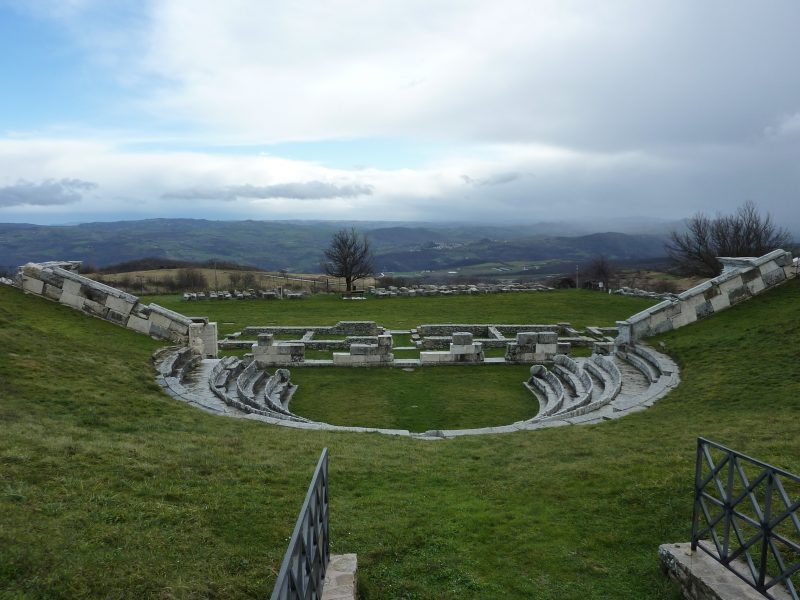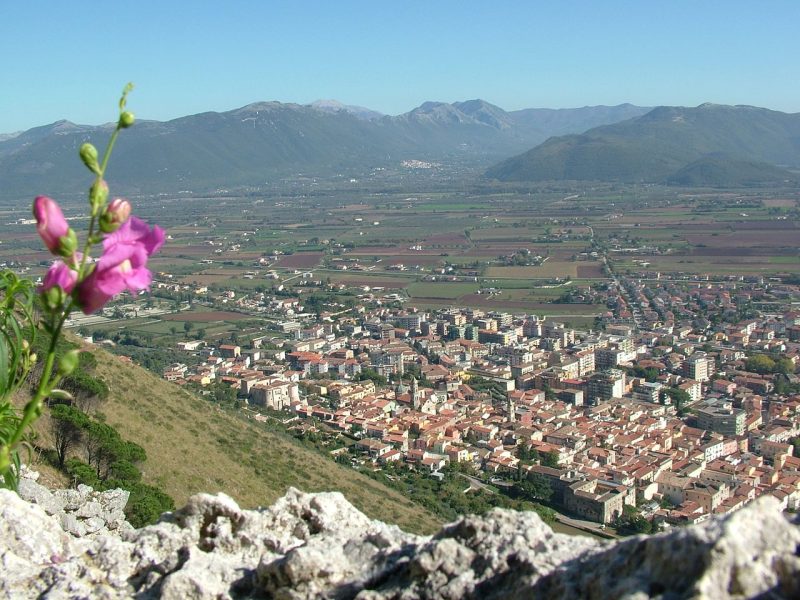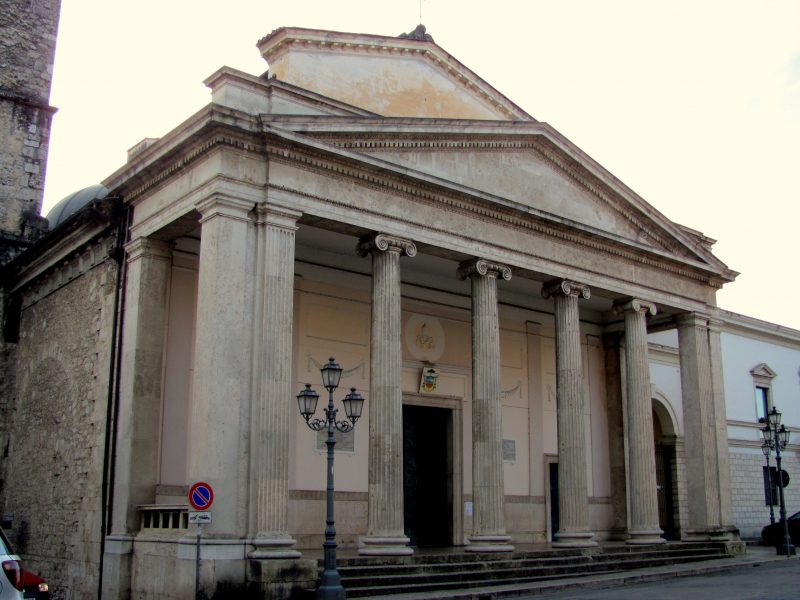The Borgo of Frosolone
Frosolone pulses with life, surrounded by a panorama of lush fields dotted with wildflowers and pale megalithic stones sculpted by time and the elements. It is a borgo of the utmost simplicity, an idyllic land of cows grazing in the pastures and horses running free.
The hammering of the forges of the master knife-makers is the sound of Frosolone, and the musical rhythm of their labor fills the inhabitants with pride. This is a borgo of extremely ancient traditions: where every August, the ancient rites of the past are celebrated in authentic period costumes, and where the mouth-watering aroma of the fresh local cheeses awaits you in the artisanal dairy, the “Casa del Pastore”, (the Shepherd’s House), which still produces cheese according to the most ancient traditions of this land, passed down over the centuries.
But Frosolone is not only simplicity and ancient traditions, it has also known pain and rebirth, and the irrepressible desire for life and happiness: an invigorating mix that is a tonic for the soul.
History
Frosolone’s history bears the scars of deep wounds, but is also marked by the enduring strength of its citizens, eager to be reborn and start anew.
Near the area of Civitelle, ancient megalithic walls are evidence of a hill settlement, which was only inhabited at certain times of the year, by populations of Oscan-Samnite origin.
Frosolone’s ancient borgo was probably linked to the Abbey of Montecassino, given the Benedictine style of the monuments in the historical center, as well as the existence of a document, conserved in the archives of the Abbey, which reports the transfer of a group of colonists to the area of Frosolone from the town of Frosinone, which according to one theory, is where the name was derived from. Others maintain that the borgo’s name is derived from the word ‘frisone’, a species of bird that is also represented in the emblem of the city.
Frosolone began to take shape as an actual urban center toward the end of the Middle Ages. In the twelfth century, the fief was governed by the noble Borello family, and then during the period of feudalism, the borgo passed through the hands of many feudal rulers.
In 1456, Frosolone’s development was brusquely interrupted by a devastating earthquake, which seriously damaged much of the Molise region.
The second half of the 1500’s heralded the advent of the Spanish domination in Southern Italy, and Frosolone began flourish once more under the new sovereigns. The town continued to develop, and in the 1800’s it became the second largest municipality in Molise, with 4,000 inhabitants. Unfortunately, nature had more unpleasant surprises in store for Frosolone, and another devastating earthquake hit the region, bringing the city to its knees.
Documents from that period cite the number of fatalities as being around 1,000, but nonetheless in 1835, Frosolone still registered as having more than 4,000 inhabitants.
The reconstruction of the city was lengthy and drawn out, and upon completion, the borgo had a whole new look: the urban plan was dramatically modified, with construction of important public works such as the sewer system, public lighting and the ‘Fonte dell’Immacolata’.
Regardless of these developments, the devastating impact of the earthquake dragged the population to the brink of an economic crisis, which led to two large migratory waves, one at the beginning of the 1900’s and one after the Second World War. At the turn of the century, many of Frosolone’s youth chose to immigrate to the United States, which is why Frosolone lost many of its sons in the tragic mining disaster of 1907 in Monongah, North Virginia.
Today, Frosolone is one of the most popular destinations in the Molise region, and the unforgettable authenticity of this timeless borgo remains in the hearts of everyone who comes to visit.
The Church of Santa Maria Assunta
La Church of Santa Maria Assunta was inaugurated in 1309. A document from the National Archives of Naples registered the transfer of the parish title from the Church of San Martino to the Church of Santa Maria Assunta, which was built at the highest point of the borgo. The building was restored and remodeled several times, due to the damage caused by earthquakes. The church and its imposing turreted bell tower face a public square that was once the central point of Frosolone, which could be reached from every direction and was the traditional meeting place of the town. The façade we see today is in Baroque style, divided by pilasters into two parts, attributed to two different periods. The more recent section is characterized by plaster-work and is clearly distinguishable from the elements dating back to the Medieval period. The portal leads to an interior with a Latin-cross layout. Two series of columns divide the space and create three naves, with the central nave characterized by a vaulted ceiling with a low cupola.
The oil paintings adorning the two side altars are from the 1700’s. They represent the Madonna with the souls in Purgatory and are the work of Giacinto Diana, a Neapolitan painter who was considered the most famous artist of his day.
The church bell in the bell tower has a name: ‘Girolamo’. A local legend says that this bell has a particularly pure sound, because when it was being made, at the moment of melding the bronze, gold was added, taken from the jewelry of the women of Frosolone, donated as a sign of faith and eternal devotion.
Chiesa di San Pietro Apostolo, The Church of St. Peter the Apostle
In 1805, an earthquake hit Molise on the day of the festival of Sant’Anna, reducing the ancient church of San Pietro Apostolo to rubble, and making space for what is today Largo Vittoria, the biggest public square in the ancient borgo. The only remaining testament to the presence of the original church are two stone lions, which once supported the columns of the church, and are now at the base of a cross that stands in the center of the piazza.
The sacred vestments of the building as well as some original elements were installed in the new church of San Pietro Apostolo, which is located a short distance from Largo Vittoria. The façade of the new church dates back to the 1940’s, created by Father Giuseppe Mario Trillo, the borgo’s priest at the time. The interior is graced by priceless works of art, such as a carved wood statue depicting the ‘Immacolata’ from the 1700’s, and above all, a marvelous sculpture of the “Sacro Cuore di Gesù’ (the Sacred Heart of Jesus) by Giovanni Duprè of Sienna, and two paintings of the “Sacra Famiglia”, (the Holy Family) created by his daughter, Amalia. The church was originally attached to the Convent of Santa Chiara.
Convento di Santa Chiara
The story of the ‘Convento di Santa Chiara’ is a troubled one, but it concludes with a happy ending. Its foundation was commissioned by Giovanni d’Evoli in 1367, who at that time held part of the fief of Frosolone. Two churches belonged to the convent, the one connected to the church of Santa Chiara, and another located in San Pietro in Valle, dedicated to Santa Maria di Loreto.
In the fourteenth century, the convent was abandoned and passed into the hands of the religious order of the ‘Frati Minore Conventuali’ who lived there until 1805, when the ‘Sant’Anna earthquake’ hit. The structure was seriously damaged in the quake, and the convent was abandoned for a brief period, but restoration began after a few years and terminated in sometime later in the nineteenth century.
The layout of the convent was not altered. Its square floor plan remained, as well as the cloister with its arched colonnade, but the internal spaces were modified because the function of the building was changed to serve various governmental bodies. First, it became the ‘Giudicato Regio del Circondario’, then a courthouse, and then, even a prison. Only in 1995 did the Municipality of Frosolone transfer its offices there, setting off a new phase of revaluation for the building.
The Zampini Baronial Palace
The Baronial Palazzo represents the center of earthly power in Frosolone. It was constructed on the city walls, but its austere defensive character has been lost over the course of the centuries.
The palace was constructed in the same location as a previous Lombard castrum, or military encampment. During the Norman period, the wealth and power of a fief was determined by the number of soldiers a feudal lord was able to maintain in his service, paying them in ounces of gold from the earnings of his feudal lands. In the twelfth century, Raynaldo di Pietrabbondante
was lord of the feudal territory of Frosolone, which generated one hundred and twenty ounces of gold, corresponding to six soldiers and six servants, meaning that the borgo was already enjoying a certain prestige.
In 1305, the palace became the headquarters of the Inquisition, and within its walls, the cruel Inquisitor, Fra Tommaso d’Aversa condemned a group of friars for heresy and locked them away in the fortress for life.
The palace underwent a profound reorganization in the 1500’s, thanks to the interventions of its inhabitants, Francesco Marchesano and later, the Della Posta family, who changed its appearance, discarding the austere vestments of a defensive fortress and transforming it into an elegant noble home.
The external appearance of the Baronial Palace exudes a sober simplicity. A staircase leads to an elegant portal, which opens onto the garden, while another door leads into the building. The ground floor consists of a series of arches supporting the upper floor, which was used by the noble family and enhanced by an esplanade, or large ornamental terrace.
Like many of Frosolone’s monuments, the Baronial Palace suffered damage in the earthquake of 1805.
The palace was purchased by the Zampini family in 1771, who still own it today. The Zampini heirs have recently restored the south façade of the building, returning it to its original color.
‘Museo dei ferri taglienti’, the Museum of Cutting Tools.
In the past, the little piazzas of Frosolone’s historical center were full of artisan workshops, which filled the borgo with the tinkling rhythm of knives being forged. Today, this ancient art is now the heritage of a few local masters, and its story told in the ‘Museo dei Ferri Taglienti”.
The museum in via Selva holds an important part of Frosolone’s artisan history, exhibiting important archeological finds such as military cutting blades, and handmade objects representative of the art of scissor and knife production. The museum safeguards more than a hundred one-of-a-kind pieces, collected over the years thanks to donations by artisans, enthusiasts, and the heirs of the local master craftsmen. There is also a genuine, fully equipped workshop set up in the museum, where you can watch the master craftsmen at the art of forging.
The “Museo dei Ferri Taglienti” can be visited all year round by appointment, and is open every day in the month of August.
“La Casa del Pastore”, the Shepherd’s House
Frosolone does not just specialized in handmade cutting tools. Another important livelihood is animal breeding and shepherding, still practiced today with the ancient methods handed down through the centuries.
The Colantuono family comes from a long line of shepherds in Frosolone, and are probably the last shepherds in Italy that practice transumanza, or transhumance, a thousand-year-old custom that involves cyclical migration of livestock on foot, following sheep, goat and cattle trails through various territories. Transhumance can be vertical, from the plains to the mountains and back again, or horizontal, driving the herds from region to region. The Colontuono family practices both types, and twice a year the shepherds lead three hundred cattle from the plains of Puglia to the green pastures of the Molise mountains.
Shepherding has put food on the table for many families in Frosolone, and today, to honor this local economy, in the historical center, at the end of via Garibaldi, there is “La Casa del Pastore”, the Shepherd’s House. It is a house-museum where a typical, traditional farmer’s kitchen has been re-created. During your visit you can participate in the preparation of various premium local cheeses, and of course, sample the cheeses! How could you resist?
“Museo del Costume e del Corredo Antico”, The Museum of Costumes and Dowry Linens
The ‘Museo del Costume e del Corredo Antico’ recounts centuries of history through the traditional costumes of Frosolone. Cultural traditions and folklore are often expressed through the antique, historical costumes worn during the important local festivals: unusual headdresses, antique lace, embroidery, and traditional colors all play their part in creating realistic historical events that are important for the whole community.
The Archeological site of Civitelle
In the rural periphery of Frosolone, in an area called Civitelle, there is an important archeological site, which makes it possible to reconstruct the history of the origins of this borgo in Molise.
Heading toward the mountain, you find the area at an altitude of about 1200 meters, in a hidden area is not immediately visible as you approach. And this is not by chance, but by the deliberate strategy of the Samnites, who once lived here. The Samnites were valorous and fierce warriors whose entire population was deliberately exterminated by the Romans about 2000 years ago:“No Roman can ever live in peace as long as the Samnites continue to exist”-Lucius Cornelius Sulla, Roman general and dictator.
What has remained of this ancient people are a system of megalithic walls, evidence of an autonomous settlement, occupied in certain periods of the year for reasons of defense.
The walls are constructed with enormous slabs of stone, placed one on top of the other, utilizing the same technique as “muro a secco”, where the use of interlocking stones in synergy with the force of gravity creates an indestructible structure without the use of fixing agents.
There are three archeological zones: the first, situated at the highest point of the site, has been the most damaged by the passing of time, and is characterized by a walled enclosure of about two hectares. In the central area, at least two different types of walls can be identified, while the third zone occupies the external area where you can see different sections of walls. It is the only part of the ancient settlement that is visible from the valley below and is also the section of the archeological site which has remained the best preserved.
While the settlement was clearly constructed for defensive purposes, it is probable that over time the function of the area changed, and that it became inhabited by an urban community, as demonstrated by the ruins of small buildings that could have been homes or shops, and the presence of ceramic objects and tiles.
There are not many hypotheses founded on this archeological site, but given the various findings, it is likely that at a certain point, the settlement was abandoned, transferring to the lower area which has smaller walls than the ancient megalithic constructions.
The Morgia Quadra Complex – Colle dell’Orso
Just a short distance from Frosolone, rising in sumptuous curves to majestic heights, you find the Morgia Quadra, a stone complex of cliffs and gigantic boulders of all shapes and forms. The morphological conformation, the movements of the earth, and the pressure of atmospheric agents have all contributed to the creation of these natural, sculptural rock formations.
The Morgia Quadra is composed of limestone, marble and clay stone formations, characterized by steep vertical walls, reaching heights of between twenty and thirty five meters.
Known also as “Colle dell’Orso” (Bear Hills), the Morgia Quadra are the most important cliffs in Molise, both historically and as a rock climbing site. There are four hundred climbing routes, with the option of creating new itineraries to suit every level of expertise. The area is surrounded by inviting green pastures where cows and sheep roam free, and where you can set up tent and camp. There are also numerous mountain shacks not far from the site, which were once used by shepherds and now are available as economical accommodations.
The Morgia Quadra is truly a paradise for rock climbers, so adventure seekers looking for an adrenaline rush, prepare yourself for an unforgettable experience. And a word of advice: we suggest you plan your climbing trip to Colle dell’Orso during the spring and summer months, when the snow has completely melted off the rocks.
The Borgo of Cutting Tools
One-of-a-kind pieces: Frosolone’s claim to fame is as the town of hand-crafted knives and scissors. And these are not just any standardized, run of the mill cutting instruments, but genuine masterpieces of craftsmanship. Each piece is forged, melded and designed with meticulous care, to guarantee quality of course, but above all, out of respect for this age-old art.
The tradition of knife-making in Frosolone has ancient origins. In the 1931 historical study, “Frosolone dall’origine all’eversione del feudalesimo,” Michele Colozza dates the origins of this art back to the period in the Middle Ages when the South of Italy was under Lombard domination. At that time, Frosolone’s main occupations were agriculture and shepherding, and to facilitate the activities related to these sectors, they began to produce blades for making work tools.
At that time, the capitals of the Lombard reign were Venice and Padua, and Medieval documents attest to the migration of Venetian artisans to the South of Italy, and in Molise in particular there was a diffusion of the art of forging.
Between the thirteenth and fourteenth centuries, there was an intensified production of swords, blades and cutting tools, especially in Campobasso and Frosolone. However, their artisanal industry risked being shut down when Charles III of the Bourbons, King of the Two Sicilies in the first half of the 1700’s, issued a decree banning the production of combat blades, in view of the industrial reorganization of the foundry and armaments sector.
After an initial period of discouragement and uncertainty, the artisans of Frosolone had the insight to keep their workshops and foundries open, shifting from the manufacture of sword blades to the production of knives and scissors.
Today, there are still many forges in Frosolone’s historical center, but in the past there were even more, and the incessant ringing of hammers on iron resounded throughout the town. The production of knives and blades was an activity that involved the entire community, and many of Frosolone’s youth spent their free time learning this ancient art.
Today that is no longer the case, as attested to regretfully by the remaining local artisans, even though this activity is still highly profitable. To honor this ancient art, the “Museo dei Ferri Taglienti” was established, and every year in the first half of August, Frosolone organizes the traditional “National Exhibition of Knives and Scissors” which attracts artisans from all over Italy, eager to display their creations. Thanks to this important national event, the master metal forgers of Maniaco in the region of Fruili, Premana, in Lombardy, Scarperia, in Tuscany and Pattada, in Sardinia, have stipulated an official bond with Frosolone: “Gemellaggio delle Lame” (Twin cities of the blade).
Rites of Passage
Frosolone heralds in the first of August with an important festival: the ancient lanes of this small borgo are animated by the joyful laughter of children and teenagers and the enthusiastic chatter of people who have come from all the neighboring towns to attend the “Sfilata di carri allegorici”. (the Parade of Allegorical Floats). This festival has ancient origins, linked to the Franciscan rite of forgiveness.
Over eight hundred years ago in 1216, St. Francis of Assisi was in prayer at the hermitage of Porziuncola, when the Virgin Mary and Jesus appeared before him. The Lord asked St. Francis what he needed in order to help human souls, and the saint asked God for forgiveness, for everyone. This gift of clemency was recognized by Pope Onorio III, who bestowed it on all of the faithful.
The presence of Capuchin Franciscan friars in Frosolone brought this tradition to the borgo, which is also linked to the “Rito delle Passate”, loosely translated as ‘rite of passage’. Starting from the first days of July, Frosolone was filled with pilgrims from all over, who slept outside the Church of San Rocco in the center of the village, all waiting to perform the “Rito delle Passate”: first, the faithful would receive the sacrament of confession and holy communion and then leave the church by the side door, returning to re-enter the church again from the main entrance. This gesture symbolized a moral and spiritual transformation: the faithful are cleansed of their sins, and then they cross the threshold of sacredness, newly pure and unstained, their souls transformed and reborn. The “Rito delle Passate” was an intimate ritual, done for the good of ones soul, and above all to receive clemency and forgiveness for the souls of deceased loved ones.
The many pilgrims brought a festive atmosphere to the borgo, which is why, in the last century, the population decided to honor their guests by setting up a wagon that paraded through the streets of the town. They decorated the wagon with leafy branches and, accompanied by the joyful music of an accordion player, the people of Frosolone drove through the streets distributing glasses of wine and tasty things to eat, starting a tradition that still continues today, becoming more elaborate every year. Over time, the number of wagons has increased, and many young people decorate them, creating parade floats depicting scenes from traditional culture. There is even a competition for the best float, which attracts even more visitors to the festivities.
The Monongah Mining Disaster
The turn of the century saw a wave of emigration from Southern Italy. Thousands of young people crossed the seas, their eyes bright with hope for the future, landing at Ellis Island, in the bay of New York, the door to America! They were all there to make their fortune, and for anyone coming from poverty, “fortune” means only one thing: work.
As soon as they landed on American soil, the first company to offer employment was the Fairmont Coal Company, which generously offered to advance the fifteen dollars needed for the trip to Monongah, a little town in the woods of North Virgina, where they would be hired to work in the coal mines. ‘This was definitely not Italy’, they thought ‘ … a whole different story!’
A miner’s work was hard, but at least it was work. They descended underground when the stars were glowing bright above them, and came back up when the sky was already dark again, as dark as their coal-stained faces, and the faces of their helpers. Every miner had two helpers, sometimes adolescents, but often children. No one was supposed to know they were there, no one bothered to give them anyprotection or insurance, in fact, no one gave them any sign of acknowledgment whatsoever.
In the mines, the Devil has only one name: ‘Grisou’, an extremely volatile gas that circulated through the tunnels and that could explode from one moment to the next, a spark was enough to set it off. Just one spark. Like the one that sparked at ten thirty in the morning on December 6, 1907. The explosion blew through miles of tunnels and, of the thousands of people who were trapped in that inferno, only five survived. From the bodies that could be recognized, 171 were Italian, and twenty of those were from Frosolone.
There were countless missing people, and because it was difficult to recover the bodies, the search went on for days. When they were finally brought above ground, the scorched faces were often unrecognizable and never identified, just as the identity of those truly responsible for the tragedy were never identified or held accountable.
The immigrants had been seeking their fortune, and low and behold, they were hired by a mining company that promised them a salary, a house, and a store for their provisions and daily needs. ‘Fortunate’ indeed: the adults were paid ten cents an hour for their back-breaking labor, and the children received small tips based on the amount of coal they brought up. They lived in dilapidated wooden shacks, which they rented for ten dollars a month, and were forced to buy their food at inflated prices from the company store. All their bills were detracted from their pay, so the workers began accumulating debt even before they started, with the fifteen dollars for their initial travel costs. They lived in a labor camp with armed guards: no one could leave until they paid their debt to the company. Above all, they paid for their ignorance, their illiteracy and their poverty. The company did not see them as young lives, full of potential, but as beasts with mountains of coal to extract.
Caterina Davia lost her husband and two children in Monongah. Their bodies were never found. She was one of the two hundred and fifty women who became a widow and lost her children. For almost thirty years she went to the mine everyday to collect a sack of coal, which she emptied into her garden, to take a little weight off her loved ones deep underground and to placate her tormented soul.
In 2007, on the one-hundred-year anniversary of the disaster, the steelworks of Agnone in Molise gave Monongah a bell in memory of the victims, and the tombs, dusty and broken after years of abandon and neglect, were repaired and put in order.
The biggest mining disaster ever in America and Italy was forgotten about for years. And worse, it had no impact on improving safety regulations in the American mining and steel industries. Just one year later in 1908, another 700 people lost their lives. Over the span of a century, North Virginia sent 20,000 people to their deaths in the mines. The last fourteen were in 2006.

 Italiano
Italiano
 Deutsch
Deutsch







